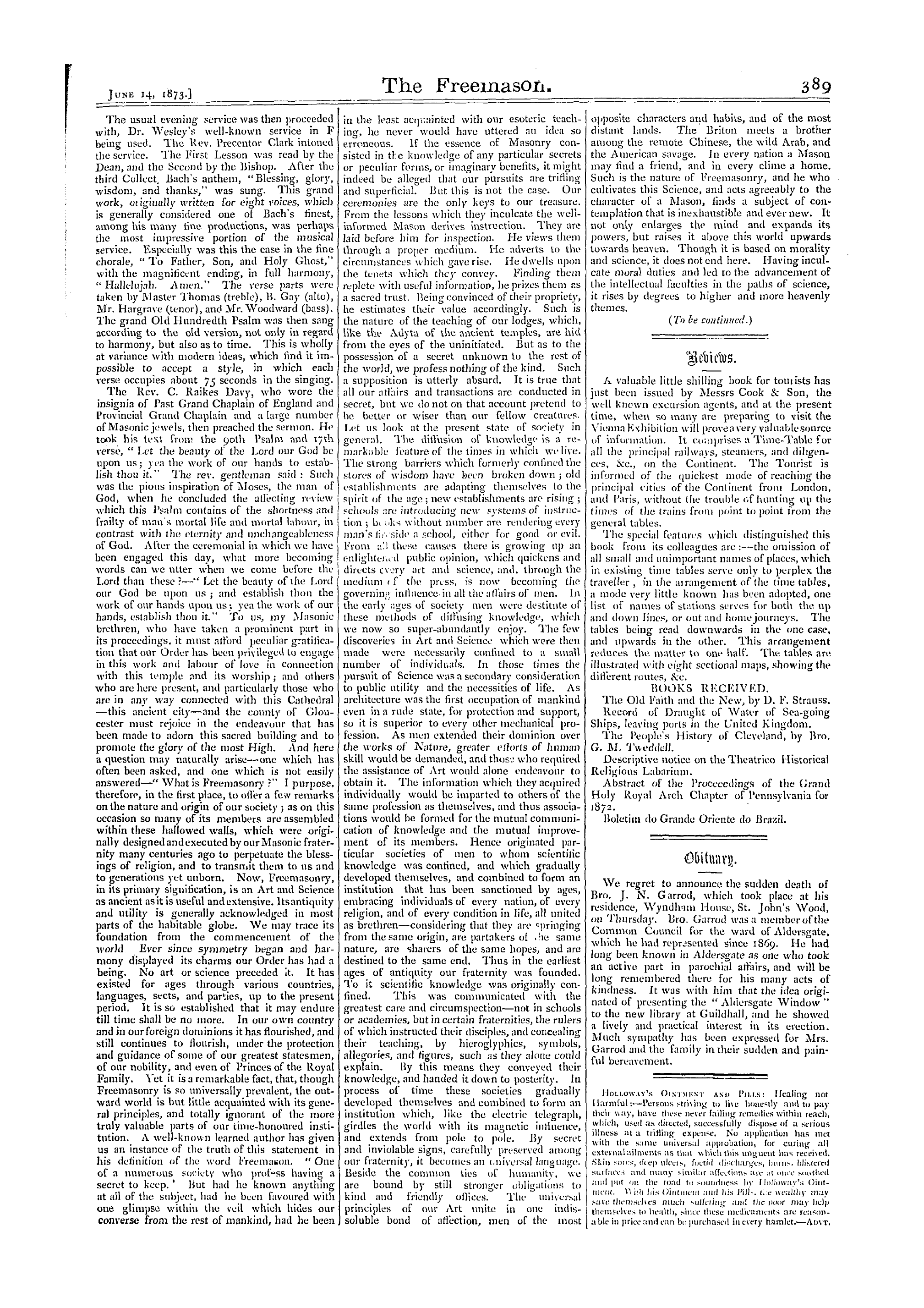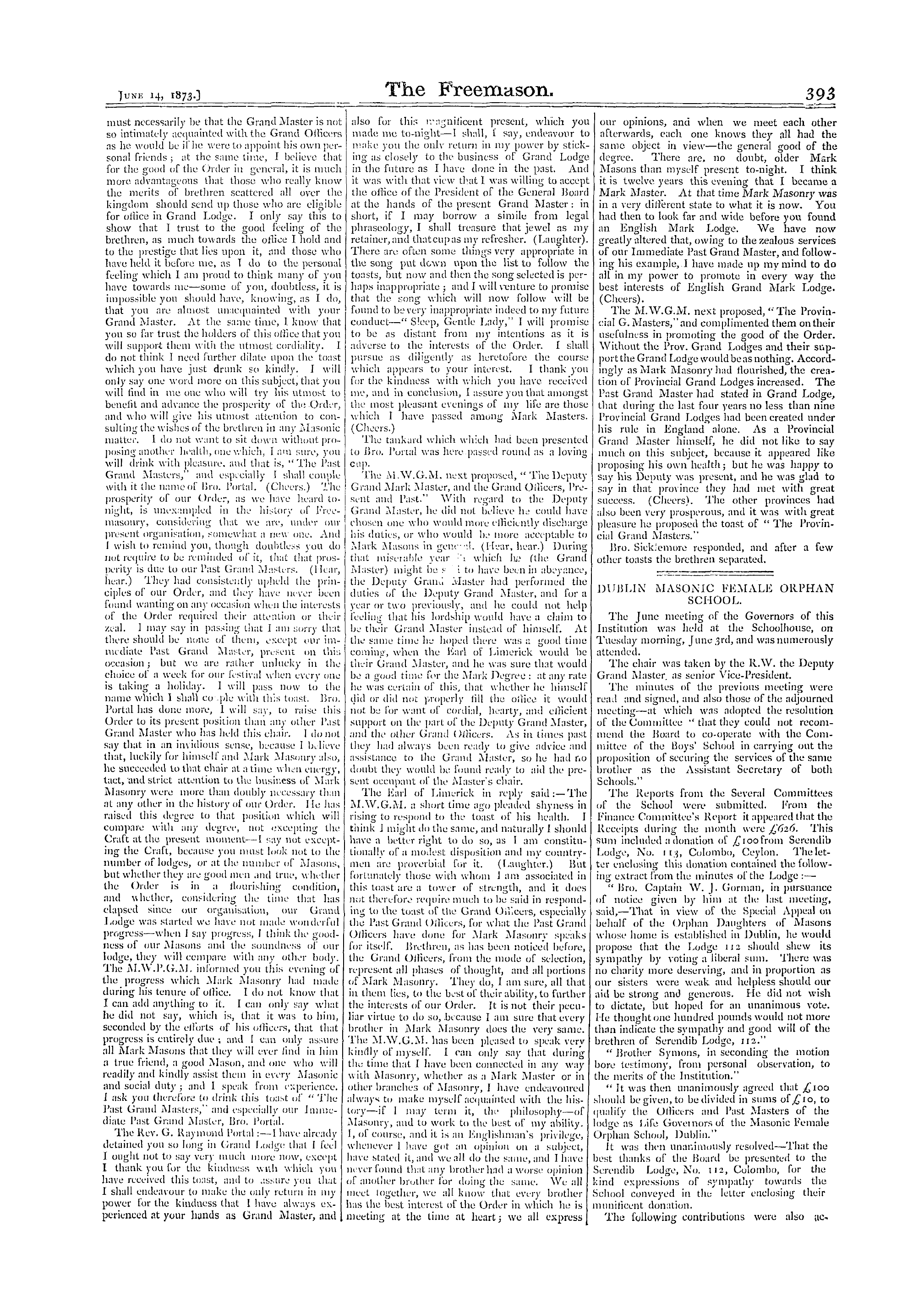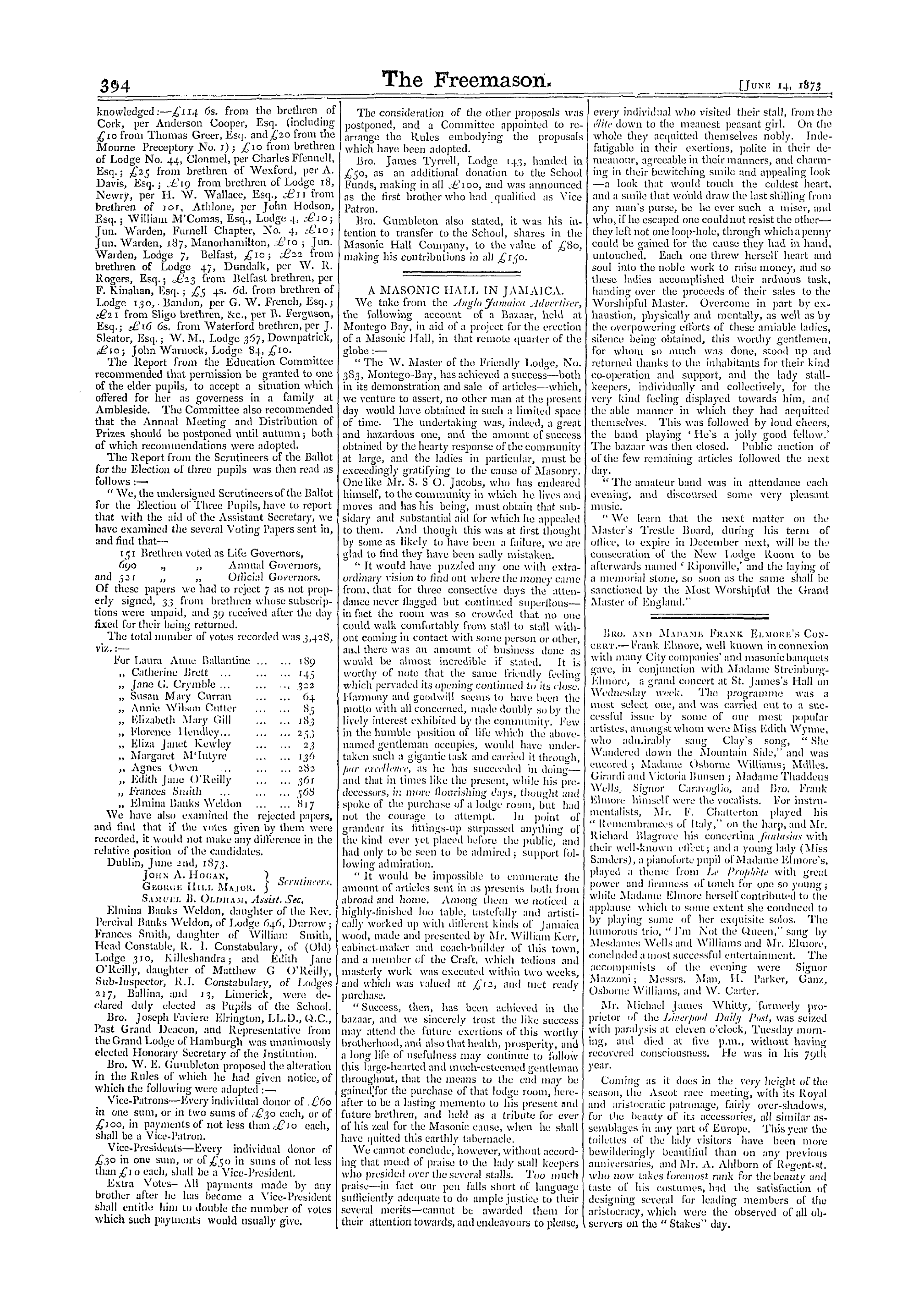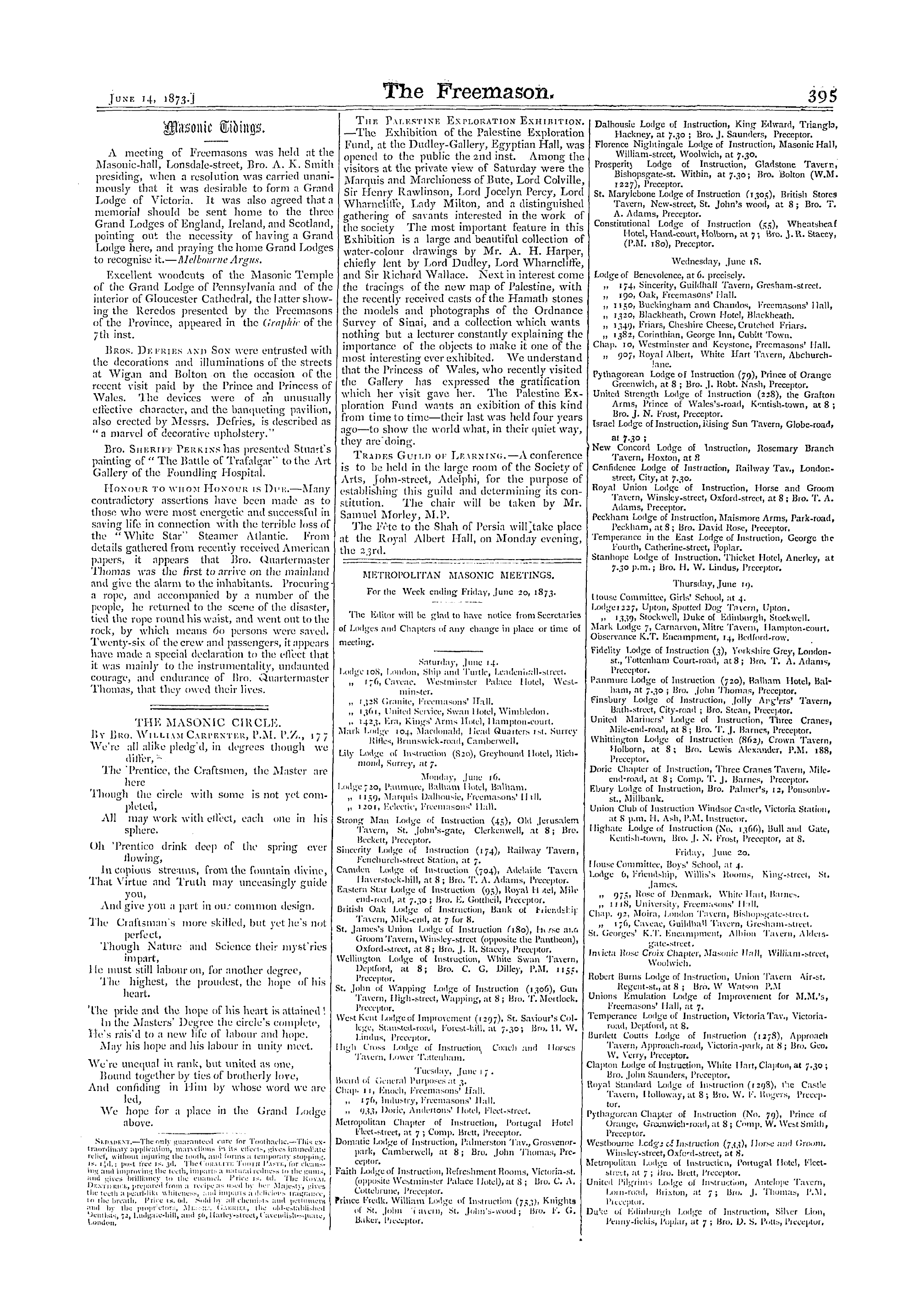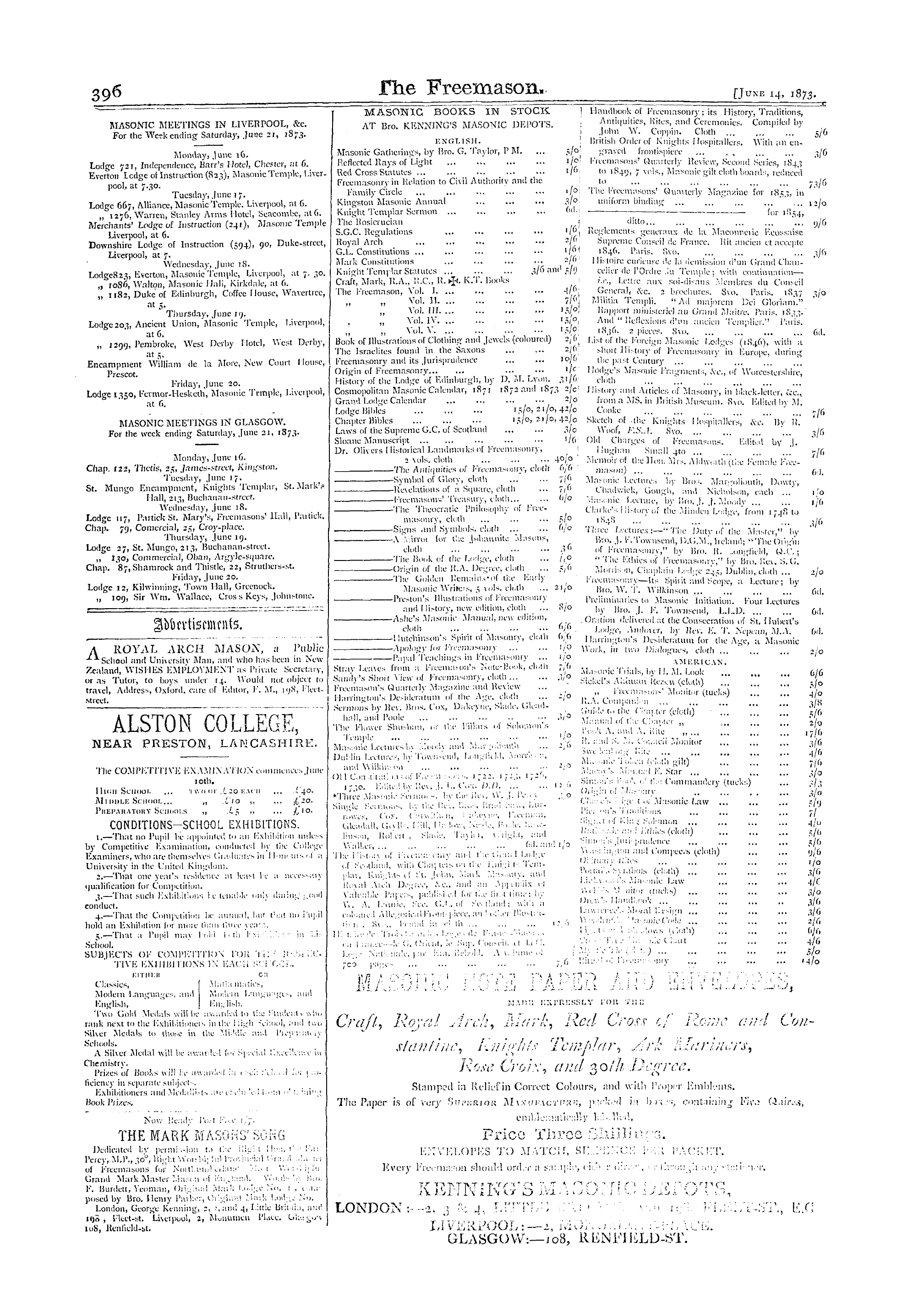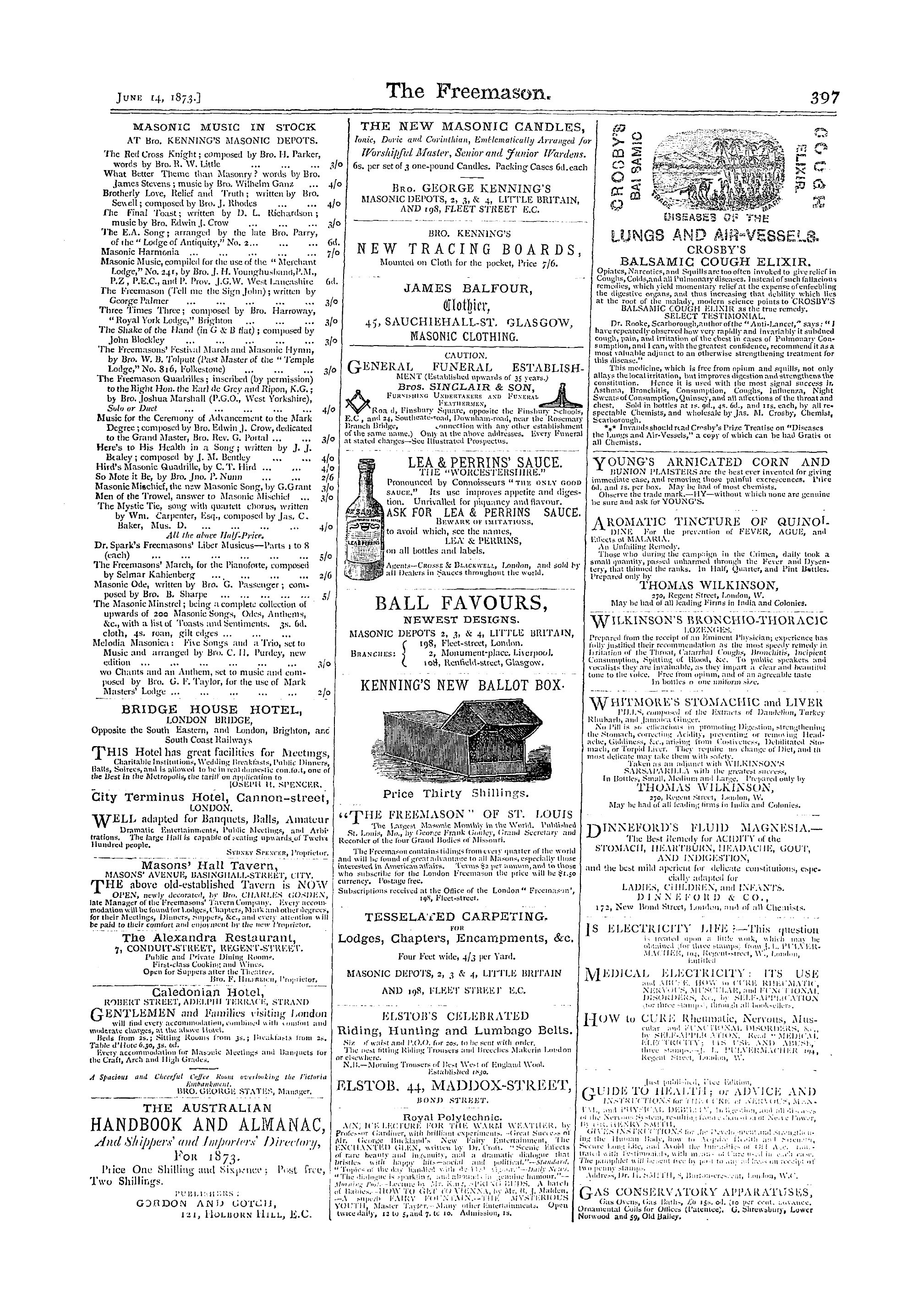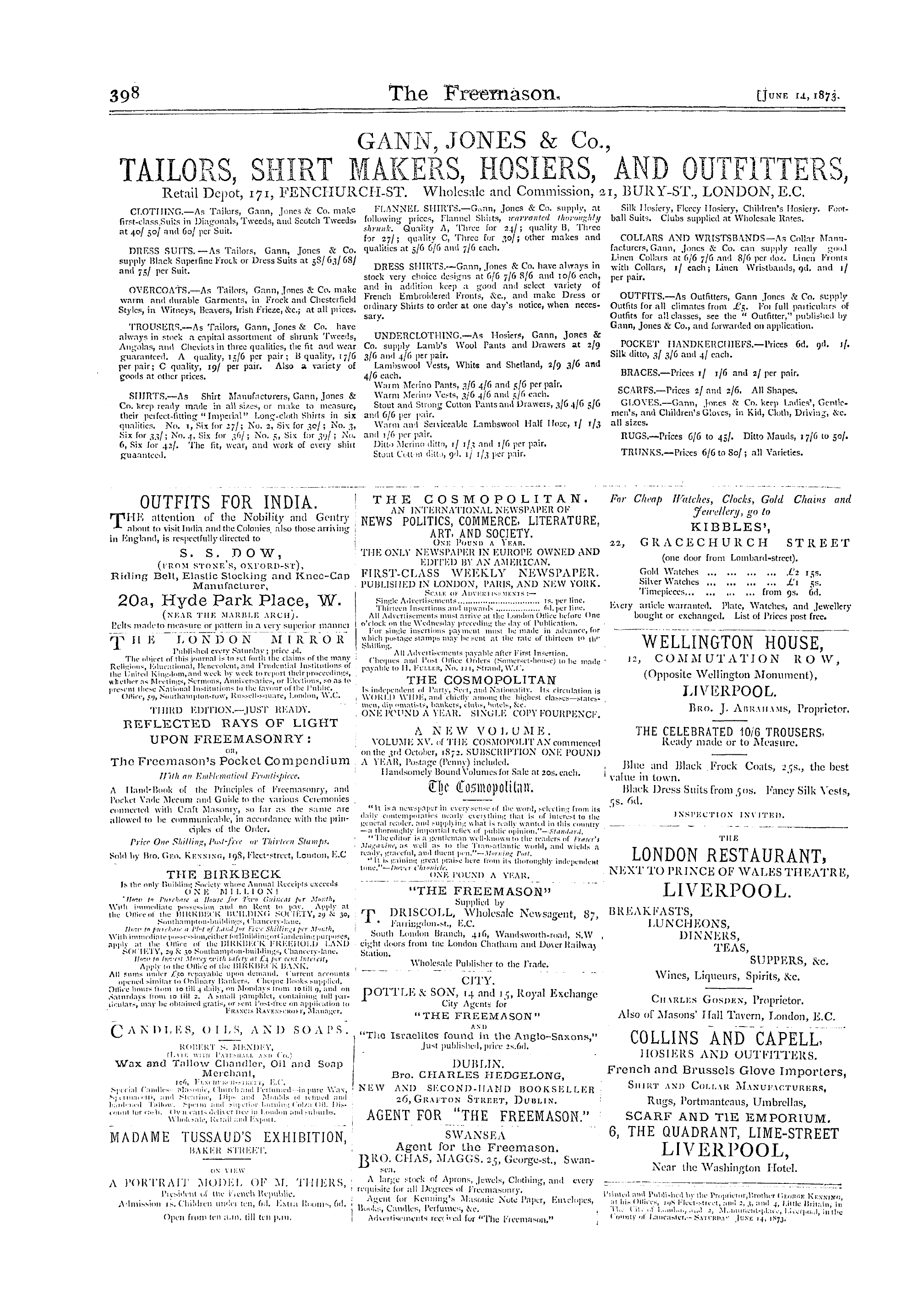-
Articles/Ads
Article UNVEILING THE REREDOS IN GLOUCESTER CATHEDRAL. ← Page 2 of 4 Article UNVEILING THE REREDOS IN GLOUCESTER CATHEDRAL. Page 2 of 4 Article UNVEILING THE REREDOS IN GLOUCESTER CATHEDRAL. Page 2 of 4 →
Note: This text has been automatically extracted via Optical Character Recognition (OCR) software.
Unveiling The Reredos In Gloucester Cathedral.
Temp le ; and it is said the architects from the African coast , Mahometans , brought it into Spain about the sixth century . Its introduction into this country took place about 674 . The Grand Lodge at York was founded in the year 926 . The finishing , if , not the erection of
many of our gothic cathedrals has been attributed to Freemasons , who , without considerations of pay , nobly devoted their lives and talents to the work of raising these " grand poems in stone , " to their eternal " Grand Master . " It is only from such devoted souls , living in a sort of
atmosphere of religions fervour that we could possibly have the first conception of the exquisite form , exquisitely wrought out so conscientiously by patient and laborious hands , as far removed from the contract spirit in which modern public buildings are erected as it is possible to conceive .
The most venerated and sacred spot of all in a church was , of course , the altar , and here it was in ancient times that the most solemn and impressive ceremonies of the church were performed , and none but the favoured few dare enter its sacred precincts . Beneath the altar ,
as the most perfect place of safety , were deposited relics and treasures , space for their reception being specially left in the shape of recesses beneath the walls , generally sunk below the level ot the floor , reached by lock-guarded doors , which were let into' the screen . The lavish
manner in which many of the altars of our church in mediieval times were enriched with gems , precious metals , exquisite carvings , and pictures—the offerings of the wealthy devotee—¦ indicate pretty accurately the spirit which prevailed . Our richest decorations , in comparison with them , appear dim and tame , though we
may claim a purer , because a simpler , taste . The magnificent reredos , however , well recalls some of the glories of our ancient altar-pieces ; while it has the merit of being in perfect harmony with the character of the venerable and stately building in which it is erected , wilh whose surroundings it blends most pleasantly , raid in accordance with the strictest canons of
taste in gothic architecture , as interpreted by the highest known authority , Sir Gilbert Scott . The Freemasons have therefore good reason to be proud of their generosity being directed into so line a channel ; and we are sure their gift will
be regarded with pleasure and gratitude alike by the church authorities , by all admirers of noble architecture , and b y the public at large , who look upon our cathedral with feelings akin to veneration .
The importance which has attached to the formal opening of this grand work justifies us in going somewhat into detail in describing its history and completion . AVe will , however , lirst briefly refer to the reredos and screen which previously existed on the site of the present new
one . Between 40 and 50 years ago an altar screen from designs by the late Mr . Smirke was erected . This consisted chieily of stone panelling , and had no pretensions to architectural 01 sculptural display . It was put in place of the older work , which Fosbrooke states was formerly
behind it , in fresco . The latter old altar-piece is stated to have been removed to the parish church of Cheltenham . In 1718 it appears thai a curious picture in distemper was discovered against thc east wall of the nave , behind the wainscoting . This was removed to the
triforium at the south transept , where it remained for many years . In the account of the cathedral published by the Society of Antiquaries in 1809 , it was stated that "it is supposed this picture once made part of the decorations of the high altar , as its dimensions agree with the
original altar screen now remaining , behind the modern one set up in the seventeenth century . " It was nine feet seven and a-quarter inches in height . It had been painted on a white plaster ground laid on oaK planking three-quarters of an inch thick . Portions onl y of the frame remained . It consisted of a striking though somewhat
rough representation of the Last Judgment , a large number of figures being represented . Mr . Scharf considered it one of the most important specimens of English painting he remembered to have seen . It was a coarse epitome of the famous altar piece at Dant / . ig , of the date of 1467 . He considered it to have been painted at the end ofthe reign of Henry VIII ., or Edward
Unveiling The Reredos In Gloucester Cathedral.
AT . Although not found /// situ at the altar , thc conclusion drawn from its dimensions , that it once occupied that place , seems to be a fair one . About two years ago , befor the commencement of the present work by Sir Gilbert Scott , the screen which had been erected by Mr . Smirke
was removed , and Air . AValler , the resident architect ofthe Cathedral , who has always taken a special interest in all that appertains to the ancient work it contains , discovered the foundations of the original reredos , with two doors of approach between the reredos and the back
screen . Each of these doors leads by three curved steps to a floor of a lower level , forming what is know as a feretory , in which it is supposed that valuables were deposited , three recesses apparently for that purpose exist beneath the altar , and two beneath the wall screen at the
back . AVe understand a very correct plan of this ancient work has been made by Mr . Waller , who also found there thc foundations of the two Norman pillars , one on each side , showing clearly , as the crypt indicates , the orig inal form of the Norman Church , prior to the
erection of the present Lady-Chapel . The lower portion of the walls nearest the east window is considered to be a part of the old chapel , and the main walls of the building , which were erected by Abbots Hanley and Farley about 1472-1 49 8 , are brought gradually from a much greater width
to the same dimensions , so as to interfere as little as possible with the light to the great east window . There is no doubt that the ancient reredos which existed on the site of the present new one was a fine structure , gorgeously painted , probably in a similar style to the four sedilia on the south
side , the colouring of which may be ( raced . These have been beautifully restored from designs by Sir Gilbert Scott , but of course without the colouring which covered the originals . The canopy work has been made to surmount
twelve statuettes , by Mr . Redfern , which have an exceedingly line effect . These represent the founder and several successive abbots who have taken the most prominent part in the construction of the building , in their order of date , the oldest standinir towards the east .
The reredos is of Pamswick stone , and screens ofthe same material are attached to it , reaching to the north and south walls of the choir , iv small portion of an embattled cornice of the ancient work , which was attached to the north
and fiotifth walls , gave the position aud leading features of the design ; the place and width ol the doors were also found from the remains ol the ancient work . The doors are of polished oak , and elaborately panelled and carved .
The lower stage of the reredos contains three lar"c niches , and four smaller ones , the bases of the niches resting on a shelf which is lour feel six inches from the level of the altar step ; in each niche there is a pedestal of a semi-octagonal form with carved cornice and ciesting , being
two feet in height from the shell . 'Phe pedestals in thc large niches support groups of sculpture , while single figures rest on those in the small ones . To each niche tliere is an elaborate canopy , delicately panelled , and with pinnacles of a highly ornamental character at the angles . The
arches to the canopies are richly moulded , ctisped , and crocheted , the bosses to the arch of the central one being formed of angles , while the vaulting is of a very intricate nature . An ornate cresting completes the cornice of these canopies , and the niches are separated by
panelled pinnacles , each having three rows ol gablets , and widened at the lower part by slightly projecting buttresses . At the extreme ends of the reredos are two large pinnacles of a similar character , and attached to the rest by llying buttresses , cusped and crocheted , the distance
between these being seventeen feet , seven inches . Over each of the large niches is a lofty canopy , with pierced tracery on each sides , and crockets at the angles , the central one being higher than the rest , and surmounted by a richly-carved and well-proportioned cross , while the other two
have carved finials . The cross is upwards of twenty-six feet from the level of the altar step . Each of the canopies has three niches , divided as before with pinnacle buttresses , each having a tall canopy , with cusped ogee arches , and ornamented with crockets at the angles . All the canopies are vaulted , and under each pedestal is
Unveiling The Reredos In Gloucester Cathedral.
an angel bearing in his hand an emblem or instrument of the " Passion . " Commencing on the north side tlie lirst carries thc dice , the next the crown of thorns , and the third the whipping post aud scourge . In the central canopy the angel carries the nails and hammer , the one in
the centre bears the cross , and the third the sponge . In the canopy on the south side the lirst angel holds the chalice , the second the spear , and the third the ladder . In the lower stage of the reredos , the first figure commencing on the north side , is Moses bearing the tablets of the
law . Next him is a subject representing the "Nativity " - —a ministering angel stands behind the figure of the Holy Child , and S . Mary kneels in an attitude of adoration beside Him ,, while S . Joseph completes the group . Next to this is a figure of S . Peter , the Patron Saint ,
bearing his emblem , thc keys . In the centre is represented the Ascension of Our Lord , His hands slightly raised in the attitude of blessing His disciples , who are kneeling in the foreground . Next to this is the figure of S . Paul bearing his emblem , the sword . Then follows the
entombment of Our Lord , S . Mary Magdalene kneels in front , while figures of the Blessed Virgin , S . J ohn , and S . Joseph of Arimathea , occupy the back ground . The series is completed by the figure of David playing on the harp . The group are two feet nine inches wide , and the single figures
are three feet six inches high . The design for the reredos was given by Sir Gilbert Scott , R . A . the masonry and carving were executed by Alessrs . Farmer and Brindley , of London ; and the sculpture is by Air . Redfern , of the same place . The stone is from the quarries belonging to
Messrs . Wingate , ol this city . 1 he contracts for the work amount to about £ 1 , 200 , which is all covered by the subscriptions given by the Freemasons . A brass-plate at the back of the reredos bears the following inseiiption : — " Glory to God in the Hig hest ! This reredos was erected and
presented by thc Freemasons of the Province of Gloucestershire , June , A . D . 187 , 3 . The Kt . Hon . Henry Legge Dutton , Barou Sherborne , P . G . M . ; GeorgeFred . Newmarch , D . P . G . M . j Thos . Gill Palmer , P . G . Treas . ; Edwd . Trinder , P . G . Sec .
A list of the subscriptions has been beautifully illuminated on vellum by Mr . J . Turner , and bound in black morrocco , forming a handsome volume . The following is a copy of the tillepage , as far as lettering goes : — " t ) n the fifth day of June Anno Domini , 187 , 3 ,
rin-: RKRi ' . nos Of the Cathedral Church ot Gloucester , having been erected at the cost of the Ancient Free and Accepted Masons of the Province of Gloucestershire , was presented to the . Dean and Chapter by the Right Honourable James Lord Sherborne , the Right Worshipful the Provincial Grand
Master , in the name and on behalf of the AIasonic body . Provincial Grand Master : The Right Hon . James Lord Sherborne . Deputy Provincial Grand Master : George Frederick Newmarch . Provincial Grand Treasurer : Thomas Gill Palmer . Provincial Grand Secretary : hid ward Trinder . "
This , as the title page of the volume , is elaborate ! ) ' and beautifully illuminated . The initial letters of the first two words are in crimson and blue , the rest ol the letters being in blue , on a finely foliated back-ground in orange . The interlaced ornament is ( irmly , though finely ,
painted , and the colours harmonise well . The names of the chief Masters of the subscribing lodges , which come next , are also brought out in brilliant colours , and surrounded by ornament . A representation of the sun in gold surmounts the letterincr : and the whole is enclosed in a
border of gold , shaded with brown . Encircled by the initial letters are represented various symbolic objects , an interpretation of which , as given by a AIasonic authority , we append . "The three lesser lights of Masonry indicate the sun , the moon , and the Alaster of the lodge . The sun , the centre of light and heat , turns the
thoughts to God that made it . The initial letter T has represented enclosed within it the moon , wilh the square and compass resting upon the tessera- of a Masonic pavement . "The square is an emblem of our duty to God and man . Inequality by its two sides , the greater and the lesser , it . teaches duty , by reminding us
Note: This text has been automatically extracted via Optical Character Recognition (OCR) software.
Unveiling The Reredos In Gloucester Cathedral.
Temp le ; and it is said the architects from the African coast , Mahometans , brought it into Spain about the sixth century . Its introduction into this country took place about 674 . The Grand Lodge at York was founded in the year 926 . The finishing , if , not the erection of
many of our gothic cathedrals has been attributed to Freemasons , who , without considerations of pay , nobly devoted their lives and talents to the work of raising these " grand poems in stone , " to their eternal " Grand Master . " It is only from such devoted souls , living in a sort of
atmosphere of religions fervour that we could possibly have the first conception of the exquisite form , exquisitely wrought out so conscientiously by patient and laborious hands , as far removed from the contract spirit in which modern public buildings are erected as it is possible to conceive .
The most venerated and sacred spot of all in a church was , of course , the altar , and here it was in ancient times that the most solemn and impressive ceremonies of the church were performed , and none but the favoured few dare enter its sacred precincts . Beneath the altar ,
as the most perfect place of safety , were deposited relics and treasures , space for their reception being specially left in the shape of recesses beneath the walls , generally sunk below the level ot the floor , reached by lock-guarded doors , which were let into' the screen . The lavish
manner in which many of the altars of our church in mediieval times were enriched with gems , precious metals , exquisite carvings , and pictures—the offerings of the wealthy devotee—¦ indicate pretty accurately the spirit which prevailed . Our richest decorations , in comparison with them , appear dim and tame , though we
may claim a purer , because a simpler , taste . The magnificent reredos , however , well recalls some of the glories of our ancient altar-pieces ; while it has the merit of being in perfect harmony with the character of the venerable and stately building in which it is erected , wilh whose surroundings it blends most pleasantly , raid in accordance with the strictest canons of
taste in gothic architecture , as interpreted by the highest known authority , Sir Gilbert Scott . The Freemasons have therefore good reason to be proud of their generosity being directed into so line a channel ; and we are sure their gift will
be regarded with pleasure and gratitude alike by the church authorities , by all admirers of noble architecture , and b y the public at large , who look upon our cathedral with feelings akin to veneration .
The importance which has attached to the formal opening of this grand work justifies us in going somewhat into detail in describing its history and completion . AVe will , however , lirst briefly refer to the reredos and screen which previously existed on the site of the present new
one . Between 40 and 50 years ago an altar screen from designs by the late Mr . Smirke was erected . This consisted chieily of stone panelling , and had no pretensions to architectural 01 sculptural display . It was put in place of the older work , which Fosbrooke states was formerly
behind it , in fresco . The latter old altar-piece is stated to have been removed to the parish church of Cheltenham . In 1718 it appears thai a curious picture in distemper was discovered against thc east wall of the nave , behind the wainscoting . This was removed to the
triforium at the south transept , where it remained for many years . In the account of the cathedral published by the Society of Antiquaries in 1809 , it was stated that "it is supposed this picture once made part of the decorations of the high altar , as its dimensions agree with the
original altar screen now remaining , behind the modern one set up in the seventeenth century . " It was nine feet seven and a-quarter inches in height . It had been painted on a white plaster ground laid on oaK planking three-quarters of an inch thick . Portions onl y of the frame remained . It consisted of a striking though somewhat
rough representation of the Last Judgment , a large number of figures being represented . Mr . Scharf considered it one of the most important specimens of English painting he remembered to have seen . It was a coarse epitome of the famous altar piece at Dant / . ig , of the date of 1467 . He considered it to have been painted at the end ofthe reign of Henry VIII ., or Edward
Unveiling The Reredos In Gloucester Cathedral.
AT . Although not found /// situ at the altar , thc conclusion drawn from its dimensions , that it once occupied that place , seems to be a fair one . About two years ago , befor the commencement of the present work by Sir Gilbert Scott , the screen which had been erected by Mr . Smirke
was removed , and Air . AValler , the resident architect ofthe Cathedral , who has always taken a special interest in all that appertains to the ancient work it contains , discovered the foundations of the original reredos , with two doors of approach between the reredos and the back
screen . Each of these doors leads by three curved steps to a floor of a lower level , forming what is know as a feretory , in which it is supposed that valuables were deposited , three recesses apparently for that purpose exist beneath the altar , and two beneath the wall screen at the
back . AVe understand a very correct plan of this ancient work has been made by Mr . Waller , who also found there thc foundations of the two Norman pillars , one on each side , showing clearly , as the crypt indicates , the orig inal form of the Norman Church , prior to the
erection of the present Lady-Chapel . The lower portion of the walls nearest the east window is considered to be a part of the old chapel , and the main walls of the building , which were erected by Abbots Hanley and Farley about 1472-1 49 8 , are brought gradually from a much greater width
to the same dimensions , so as to interfere as little as possible with the light to the great east window . There is no doubt that the ancient reredos which existed on the site of the present new one was a fine structure , gorgeously painted , probably in a similar style to the four sedilia on the south
side , the colouring of which may be ( raced . These have been beautifully restored from designs by Sir Gilbert Scott , but of course without the colouring which covered the originals . The canopy work has been made to surmount
twelve statuettes , by Mr . Redfern , which have an exceedingly line effect . These represent the founder and several successive abbots who have taken the most prominent part in the construction of the building , in their order of date , the oldest standinir towards the east .
The reredos is of Pamswick stone , and screens ofthe same material are attached to it , reaching to the north and south walls of the choir , iv small portion of an embattled cornice of the ancient work , which was attached to the north
and fiotifth walls , gave the position aud leading features of the design ; the place and width ol the doors were also found from the remains ol the ancient work . The doors are of polished oak , and elaborately panelled and carved .
The lower stage of the reredos contains three lar"c niches , and four smaller ones , the bases of the niches resting on a shelf which is lour feel six inches from the level of the altar step ; in each niche there is a pedestal of a semi-octagonal form with carved cornice and ciesting , being
two feet in height from the shell . 'Phe pedestals in thc large niches support groups of sculpture , while single figures rest on those in the small ones . To each niche tliere is an elaborate canopy , delicately panelled , and with pinnacles of a highly ornamental character at the angles . The
arches to the canopies are richly moulded , ctisped , and crocheted , the bosses to the arch of the central one being formed of angles , while the vaulting is of a very intricate nature . An ornate cresting completes the cornice of these canopies , and the niches are separated by
panelled pinnacles , each having three rows ol gablets , and widened at the lower part by slightly projecting buttresses . At the extreme ends of the reredos are two large pinnacles of a similar character , and attached to the rest by llying buttresses , cusped and crocheted , the distance
between these being seventeen feet , seven inches . Over each of the large niches is a lofty canopy , with pierced tracery on each sides , and crockets at the angles , the central one being higher than the rest , and surmounted by a richly-carved and well-proportioned cross , while the other two
have carved finials . The cross is upwards of twenty-six feet from the level of the altar step . Each of the canopies has three niches , divided as before with pinnacle buttresses , each having a tall canopy , with cusped ogee arches , and ornamented with crockets at the angles . All the canopies are vaulted , and under each pedestal is
Unveiling The Reredos In Gloucester Cathedral.
an angel bearing in his hand an emblem or instrument of the " Passion . " Commencing on the north side tlie lirst carries thc dice , the next the crown of thorns , and the third the whipping post aud scourge . In the central canopy the angel carries the nails and hammer , the one in
the centre bears the cross , and the third the sponge . In the canopy on the south side the lirst angel holds the chalice , the second the spear , and the third the ladder . In the lower stage of the reredos , the first figure commencing on the north side , is Moses bearing the tablets of the
law . Next him is a subject representing the "Nativity " - —a ministering angel stands behind the figure of the Holy Child , and S . Mary kneels in an attitude of adoration beside Him ,, while S . Joseph completes the group . Next to this is a figure of S . Peter , the Patron Saint ,
bearing his emblem , thc keys . In the centre is represented the Ascension of Our Lord , His hands slightly raised in the attitude of blessing His disciples , who are kneeling in the foreground . Next to this is the figure of S . Paul bearing his emblem , the sword . Then follows the
entombment of Our Lord , S . Mary Magdalene kneels in front , while figures of the Blessed Virgin , S . J ohn , and S . Joseph of Arimathea , occupy the back ground . The series is completed by the figure of David playing on the harp . The group are two feet nine inches wide , and the single figures
are three feet six inches high . The design for the reredos was given by Sir Gilbert Scott , R . A . the masonry and carving were executed by Alessrs . Farmer and Brindley , of London ; and the sculpture is by Air . Redfern , of the same place . The stone is from the quarries belonging to
Messrs . Wingate , ol this city . 1 he contracts for the work amount to about £ 1 , 200 , which is all covered by the subscriptions given by the Freemasons . A brass-plate at the back of the reredos bears the following inseiiption : — " Glory to God in the Hig hest ! This reredos was erected and
presented by thc Freemasons of the Province of Gloucestershire , June , A . D . 187 , 3 . The Kt . Hon . Henry Legge Dutton , Barou Sherborne , P . G . M . ; GeorgeFred . Newmarch , D . P . G . M . j Thos . Gill Palmer , P . G . Treas . ; Edwd . Trinder , P . G . Sec .
A list of the subscriptions has been beautifully illuminated on vellum by Mr . J . Turner , and bound in black morrocco , forming a handsome volume . The following is a copy of the tillepage , as far as lettering goes : — " t ) n the fifth day of June Anno Domini , 187 , 3 ,
rin-: RKRi ' . nos Of the Cathedral Church ot Gloucester , having been erected at the cost of the Ancient Free and Accepted Masons of the Province of Gloucestershire , was presented to the . Dean and Chapter by the Right Honourable James Lord Sherborne , the Right Worshipful the Provincial Grand
Master , in the name and on behalf of the AIasonic body . Provincial Grand Master : The Right Hon . James Lord Sherborne . Deputy Provincial Grand Master : George Frederick Newmarch . Provincial Grand Treasurer : Thomas Gill Palmer . Provincial Grand Secretary : hid ward Trinder . "
This , as the title page of the volume , is elaborate ! ) ' and beautifully illuminated . The initial letters of the first two words are in crimson and blue , the rest ol the letters being in blue , on a finely foliated back-ground in orange . The interlaced ornament is ( irmly , though finely ,
painted , and the colours harmonise well . The names of the chief Masters of the subscribing lodges , which come next , are also brought out in brilliant colours , and surrounded by ornament . A representation of the sun in gold surmounts the letterincr : and the whole is enclosed in a
border of gold , shaded with brown . Encircled by the initial letters are represented various symbolic objects , an interpretation of which , as given by a AIasonic authority , we append . "The three lesser lights of Masonry indicate the sun , the moon , and the Alaster of the lodge . The sun , the centre of light and heat , turns the
thoughts to God that made it . The initial letter T has represented enclosed within it the moon , wilh the square and compass resting upon the tessera- of a Masonic pavement . "The square is an emblem of our duty to God and man . Inequality by its two sides , the greater and the lesser , it . teaches duty , by reminding us






